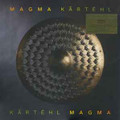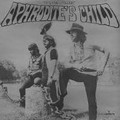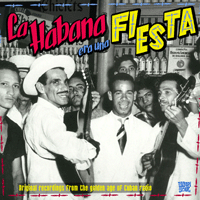 Loading... Please wait...
Loading... Please wait...Categories
Currency Converter
Choose a currency below to display product prices in the selected currency.
Add to Wish List
You Recently Viewed...
New Products
-
$25.12

-
$43.69

-
$34.95

-
$13.66

-
$16.38

Our Newsletter
V.A.-La Habana era una fiesta-40s to 60sSpanish music in Cuba-new 2CD
Product Description
V.A.-La Habana era una fiesta-40s to 60sSpanish music in Cuba-new 2CD
Various Artists
La Habana era una fiesta
NEW 2XCD Digipack.
Double CD of recordings from the 40s to the 60s by Cuban artists performing Spanish songs and by Spanish musicians that visited Cuba and were influenced by the island's music.
The tracks by Spanish artists were recorded at radio stations in Havana and are released here for the first time.
Featuring performances by essential artists from both countries such as Conchita Piquer, Celia Cruz, Antonio Molina, Orquesta Aragón, Lola Flores, Los Xey, Ernesto Lecuona, Los Chavales de España, Tito Gómez y Orquesta Riverside…
When Havana was a party, many Spaniards joined the dance. In this process of transculturation, which came from way back, music and musicians played an essential part. Having arrived from Spain, artists of the song and theatre contributed to define the DNA of Cuban popular music. At the same time, other musicians brought in essential aspects of Afro Cuban folklore to the Spanish song. In a stroke of ineffable good fortune, music has always played an intrinsic role between Cuba and Spain.
It was an elemental process: after the Spanish disaster of 1898, emigrants and soldiers, wine-producers and sailors arrived or stayed in Cuba, and with them their customs and habits. With the children of the metropolis, the companies of popular singers, zarzuela groups, and costumbrista theatre arrived. Also the music from Andalusia, traditional dancing, and genuine flamenco soon disembarked in the port of San Cristóbal de la Habana. On their way back, when they left Cuba, the ships with the gold from America also carried new melodies and rhythmical cells, harmonic gyrations, and choreographed elements of Afro-American inspiration.
On firm ground, the native Spanish colony in Cuba kept growing in numbers and importance. Half a century later, there were five million residents in Cuba. At the beginning of the 50s, one million of them resided in Havana. And there were 120,000 people who were associated to one of the many emigrant clubs founded in the city. It was there, in the halls of the societies of emigrants from Galicia, Asturias, Andalusia and the Canary Islands, where the music from both shores embraced. In décimas and folk songs, the poetic expression of Cubans and Spaniards took root on the singers' island. The landing of Spanish music in Cuba stood out in Havana with musical theatre of which operas and zarzuelas were always played as if in the old country.
The visits from Carmen Amaya, Conchita Piquer, Juanita Reina, and Imperio Argentina were lauded. From the mid-30s until approximately 1960, leading Cuban radio stations such as CMQ and Radio Progreso hired the most famous Spanish artists (and also many hustlers who came to America looking for riches) to broadcast the performances and variety shows with live music of Los Chavales de España, Los Bocheros or Los Churumbeles. The extensive reach of radio and cinema, together with the growing popularization of vinyl, enabled the quick commercial expansion of Cuban music with arrangements of danzón orchestras, sextets of son cubano, and jazz bands Cuban-style. From Rita Montaner and Bola de Nieve to Miguelito Valdés, Antonio Machín, Julio Cuevas, Bebo Valdés and Armando Oréfiche. With them, Havana was a party. Half a century before the Buena Vista Social Club.
Tracks list
1. María de la O/La bien pagá (Fuico con Papín y sus Rumberos)
2. Soleá (Celia Cruz y Orq. Suaritos)
3. Mala entraña (Dominica Verges con El Trío de Luisito Plá y la Orq. Almendra de Abelardito Valdés)
4. Traición (Carlos Díaz y Orq. de Osvaldo Estivill)
5. Zambra gitana (Ernesto Lecuona al piano)
6. El boogievá (Obdulia Breijo con Orquesta
7. Gitanilla morena (Rosita Fornés y Orq. Riverside)
8. La violetera (Paulina Alvarez)
9. Amapola (Tito Gómez y Orq. Riverside)
10. La hija de Juan Simón (Abelardo Barroso y Orq. Sensación de Rolando Valdés)
11. El centavo mágico (Rolando Ochoa)
12. La verbena de la Paloma (Antonio María Romeu al piano)
13. En el mundo (Aquilino y su Cuadrilla
14. Clavelitos (Orquesta Aragón)
15. Monísima (Nelson Pinedo y Orquesta
16. Nena (Celeste Mendoza)
17. Andalucía/Danza Nº 5 (Omara Portuondo y Quinteto de Julio Gutiérrez)
18. La virgen de la Macarena (Celia Cruz y Orquesta Suaritos)
19. Madrid (Orquesta Sensación de Rolando Valdés)
20. Y a mí qué (Los Chavales de España)
21. Las dos rosas (Niño De Utrera)
22. El palacio sin novedad (Los Xey)
23. ¡Ay! Malvaloca (Conchita Piquer con Orquesta)
24. Cuba no debe favores (Antonio Molina y Orquesta Montilla)
25. Calle abajo (Juan Legido)
26. El hijo de nadie (Trini Morén Y Niño de Utrera
27. María Dolores (Los Chavales de España)
28. No me llames (Dolores Conchita Piquer con Orquesta)
29. La rana (Los Xey y Orquesta)
30. El televisor (Lola Flores)
31. La leyenda del beso (Los Churumbeles de España)
32. Cuba de mi amor (Los Chavales de España)
33. A la lima y al limón (Conchita Piquer)
34. A orillas del Ebro (América Paz Y Rafael Ortega al piano)
35. Son mentiras (Los Xey)
36. Las bodas de Luis Alonso (Orquesta Solera de España)
“For fans of Cuban music – and anyone interested in old Spanish popular music – ‘La Habana era una fiesta’ is an essential purchase. Radio recordings ensure fine sound quality. 4 stars”.
"Exuberant and celebratory, full of flute toodles, razzy horns, percussive cha-cha-cha, and hysterically romantic vocals."
"This production, which consists of two formidable compact, gives us an idea of ??the historical effect of Spanish music in Cuba, not only in his lyrics, but also through their abundant presence."











